
A Packet of Cornflakes: Childhood in Wartime Brisbane
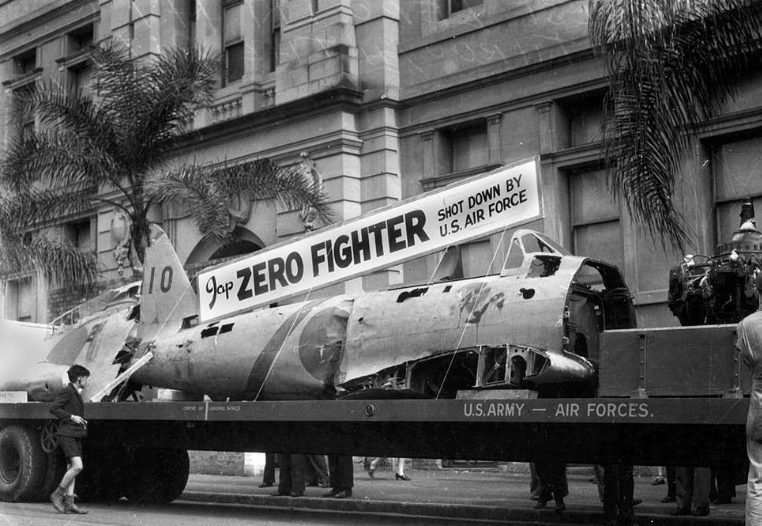
At the beginning of 1940 the population of Brisbane was about 300,000. My brother Jimmy, aged seventeen, the eldest of three sons, having raised his age by two years and forged our parents’ consent to his enlistment, was training to be a dispatch rider in the Australian Ninth Division. In July of that year, my father, aged thirty-nine, to the dismay of my mother, was improbably accepted for the Air Force. He was soon promoted. A photograph of him as a recruiting sergeant in Brisbane, seated at his desk surrounded by young women eager to volunteer for the Women’s Auxiliary Air Force (WAAF), remains annoyingly elusive.
This memoir appears in the latest Quadrant.
Click here to subscribe
Despite the 12,000 or so miles separating Brisbane from Europe, the progress of the war in Europe was a matter of continuing concern to most people. My real consciousness of the war began in early 1942. It must have been in February that I overheard my father whispering to my mother that the Prince of Wales and the Repulse had been sunk off Singapore, and that arrangements might need to be made for the family to be evacuated from Brisbane.
It was about then that I began my primary education at the local state school in a fine new building with two floors of reinforced steel concrete above, and a bomb-proof basement below. Every morning at eleven o’clock, an air raid siren sounded as a signal for an air raid drill consisting of a disorderly descent by the whole school to the basement to sit until the siren stopped.
A brown-out was imposed on the city. Some people covered their windows with criss-crossed tape as a precaution against the splintering of glass that never happened. Charcoal burners to power private cars appeared regularly on the streets.
With less skill, and much less enthusiasm than an Amish community building a barn, neighbours 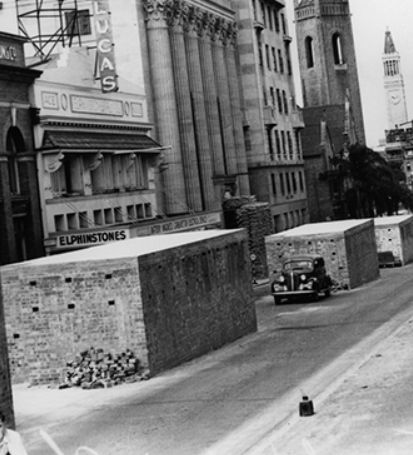 joined in making air raid shelters on each lot, usually trenches covered with semi-circular sheets of corrugated iron. They were mosquito hatcheries after rain, and were soon filled in by the residents. In public places the authorities built reinforced concrete bomb shelters (right), rectangular boxes which were later converted by removing the walls into shelters at bus and tram stops. My mother helped me to make a Victory Garden, a few lettuces and cabbages, beans and carrots. They did marginally better than the suburban shelters.
joined in making air raid shelters on each lot, usually trenches covered with semi-circular sheets of corrugated iron. They were mosquito hatcheries after rain, and were soon filled in by the residents. In public places the authorities built reinforced concrete bomb shelters (right), rectangular boxes which were later converted by removing the walls into shelters at bus and tram stops. My mother helped me to make a Victory Garden, a few lettuces and cabbages, beans and carrots. They did marginally better than the suburban shelters.
Jimmy’s pre-embarkation leave ended with a party at our house. I was allowed to stay up for the occasion. Jimmy, baby-faced, charming and wild, had no shortage of admirers. As proxy for him, I was kissed lightly on the lips by Grace of the flowing red hair. Even a child could sense lost chance, and danger. And there was more to come.
The great American general, Douglas MacArthur, came to town, making as impressive an entry to the Brisbane stage as Olivier made anywhere. And with him came the American military-industrial complex. Sealed roads, military encampments and military hospitals appeared almost overnight. He established his headquarters in a building appropriated from the AMP insurance company for the duration. The building now houses the MacArthur Museum.
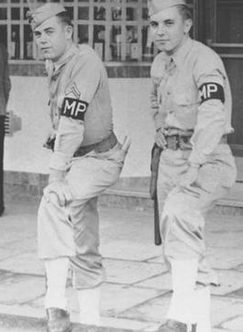 The Americans came in their hundreds of thousands. It was not a case of “Yanks go home”. Rather it was “Yanks come hither.” As in the United Kingdom, the Yanks were better paid, better tailored, better equipped and better provisioned with access to their PX—an Aladdin’s Cave of cigarettes, nylons, candy (as they called it) and Coca-Cola—than the Australians.
The Americans came in their hundreds of thousands. It was not a case of “Yanks go home”. Rather it was “Yanks come hither.” As in the United Kingdom, the Yanks were better paid, better tailored, better equipped and better provisioned with access to their PX—an Aladdin’s Cave of cigarettes, nylons, candy (as they called it) and Coca-Cola—than the Australians.
They tended to be generous with their money and their largesse. My elder brother Peter and I gasped and spluttered on our first cigarette, a brutal Camel he extracted from a packet left lying around at a party at the house of my attractive cousins, three of whom were young women between sixteen and twenty-three. As we persevered with our Camel, Peter and I sipped on our first Coca-Cola, a gift from Oliver, an American soldier who was courting, and later married, cousin Rose.
Jimmy sailed for North Africa on the Queen Mary, its grand state-rooms converted into dormitories for other ranks. Consistent with his falsification of his application for enlistment. Jimmy’s premature twenty-first birthday was recorded in a certificate as having occurred on the voyage, complete with a watercolour miniature of him painted by an enterprising soldier for two-and-sixpence. That certificate, which I once possessed, like the photograph of my father also remains fugitive.
In 1942, my father successfully applied for officer training at Point Cook, the RAAF base near Melbourne. He was the oldest man of his intake and, very possibly, when commissioned, the oldest pilot officer in the Air Force.
In the meantime, Jimmy had survived the siege of Tobruk and the victorious second battle of El Alamein. It is an entrenched piece of Anzac apocrypha that Rommel said that if he had the choice, he would use Australian troops to take Tobruk and New Zealanders to hold it.
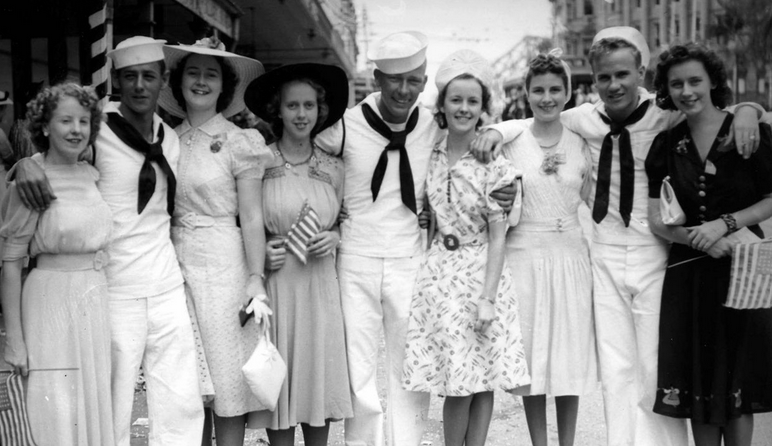
In 1943 my father, promoted to flying officer, was serving at Milne Bay in New Guinea, attached as meteorology officer to an Australia fighter squadron flying P-40 Kitty Hawks. This explains why throughout his life he maintained an intense interest in the weather. Even in the delirium of recurrent post-war bouts of malaria contracted in New Guinea, he never spoke of a climate crisis, a topic on which I would have preferred his opinion over that of the ill-mannered, uneducated child who berated an assembly of supine adults in the House of Commons.
Returned to Australia, and married to my favourite in-law Betty in Sydney, Jimmy was posted to the Atherton Tableland for jungle training. It is barely credible but well corroborated that he went AWOL, and talked his way onto General Kenny’s personal aircraft to fly from Cairns to Milne Bay, as he told it, to see how the old man was getting on. When the general, commander of all Allied air forces in the South Pacific, arrived at Milne Bay, both the US Air Force, which had by then established a major base there, and the Australians were lined up to welcome their commander.

My father was alarmed to notice Jimmy, after the general’s retinue disembarked, quietly and quickly descending from the rear of the aircraft and heading for the Australian encampment. My father was worried that he would be posted as a deserter. Jimmy stayed for a few days before my father was able to arrange for him to return on an RAAF transport. Asked later whether he saw the general on the aircraft, Jimmy said, “Yes, I was on the floor at the back and when he came down there, he said ‘Hello son’.”
Jimmy pleaded to the lesser charge of being AWOL, duly served his time, and was then deployed to Milne Bay where he had a second, less tense reunion with his father, before taking part in the amphibious invasion of Lae.
I remember the morning in Brisbane in September 1943 when a neighbour brought in the Courier-Mail, pointing to a story on page three. It is the only time I have ever seen a person faint, as my mother did with shock after reading only the first two paragraphs:
Buried by Jap Bomb
New Guinea, Tuesday.—A Queensland dispatch rider, Signaller Jimmie Callinan, had to be “dug out” by American rescuers after a Jap bomb had buried him under several feet of earth near Lae.
Callinan was riding his bicycle along the road near the beach-head when Jap bombs began to fall. He took refuge in a channel at the side of the road, but one of the bombs landed within a few feet of him, and he was buried in a shower of earth.
If she had read on she would have seen that although Jimmy’s motorcycle was destroyed, he had been rescued by some American soldiers on their second attempt, and was largely uninjured.
Forty-five years later, in Lae, briefed by an insurance company to defend a claim for business interruption arising out of the destruction by fire of a brewery, I asked in vain of the locals whether they were aware of any relics on or about the nearby foreshores of the allied amphibious operations there in 1943.
I had several reasons to recall these old wartime affairs a few weeks ago. I was reading Giles Milton’s Checkmate in Berlin, the climax of which is the Berlin Airlift from June 1948 to May 1949, when I came upon this passage:
The British ground staff at Gatow airfield had grown used to witnessing the unexpected, but everyone was taken aback when a lumbering Avro Tudor aircraft landed without warning one September morning, ten weeks into the siege. The plane itself raised eyebrows, for the Tudor was a noisy beast with a dubious safety record. The pilot was to cause an even greater stir. One of Gatow’s medical officers, Alf Johnson, did a double take when he saw the man jump down onto the tarmac, for he was dressed in pinstripe trousers and a homburg and was carrying a smart leather briefcase. He looked as if he was heading to a board meeting in the City of London.
It took less than a minute for his identity to become apparent. His name was Don Bennett and he had arrived in Berlin with a forceful personality and an illustrious wartime record. Bennett had been commander of the Pathfinder Force, the elite corps of the Royal Air Force that had been in the vanguard of every major bombing raid over Germany.

My father used to speak in awe of Don Bennett (above, arriving in Berlin). He was a Brisbane boy who had transferred from the RAAF to the RAF in 1931. A brilliant pilot and navigator, he had been shot down in the raid on the Tirpitz in a Norwegian fiord, bailed out, for several days evaded capture by the Nazi occupiers, and crossed the high snowy border to reach neutral Sweden where he was able to board a diplomatic flight to London. Later he would command the Pathfinders.
Bennett’s exploits in the Berlin Airlift were described in Checkmate in Berlin in this way:
Bennett worked around the clock, converting his second Avro Tudor into an air tanker that could carry nine tons of diesel oil into the city. He flew three nightly sorties into Berlin for two months without a break, a feat that earned him the lasting admiration of Edwin Whitfield. “An epic of human endeavour,” said Whitfield. “[It] can have few parallels in the history of aviation.”
I immediately obtained and read Bennett’s own matter-of-fact memoir, Pathfinder. It is almost possible to understand, but never to forgive, the British establishment for not conferring a knighthood upon this heroic, brilliant if sometimes difficult double DSO, the youngest air vice-marshal in the RAF. It is more than ironic that his elder brother, Arnold, who also served but only in Australia, was subsequently knighted for services to the law. He was Sir Joh Bjelke-Petersen’s favourite QC.
Another reason for recalling old events was a Brisbane launch I did, of The Tokyo War Crimes Tribunal: Law, History and Jurisprudence by Cohen and Totani, a valiant, able, but inevitably impossible attempt to analyse in strict legal terms the reasoning of the judges of the International Military Tribunal for the Far East, surgically excised from the geopolitics of the post-war world. The launch was fittingly at the MacArthur Museum. Another Brisbane connection was the appointment by MacArthur of the Chief Justice of Queensland, Sir William Webb, subsequently elevated to Justice of the High Court of Australia, as president of the tribunal. His successor as Queensland Chief Justice was to be Sir Alan Mansfield, who was a senior prosecutor at the trials.
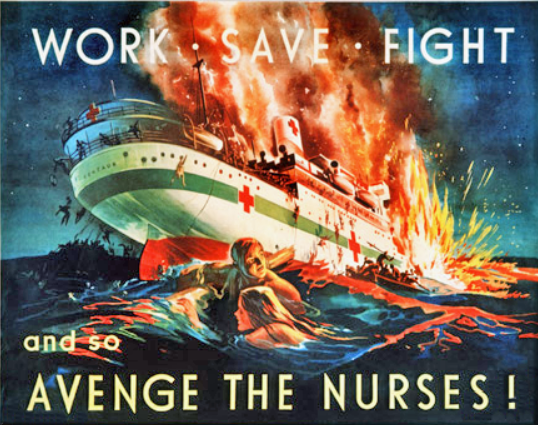
The closest enemy hostilities ever came to Brisbane was the torpedoing, in blatant contravention of the Geneva Convention, by a Japanese submarine at four in the morning on May 14, 1943, of a fully illuminated, white Australian hospital ship, the Centaur, bearing green stripes and red crosses, about fifty miles north-east of the city. The captain of the submarine was later identified, tried and convicted for different war crimes.
There were never armed enemy hostilities in Brisbane, but there were hostilities between Australian and US servicemen in November 1942. They began, predictably, with an argument about a young woman, ascending to gunfire in which one Australian was killed and many US and Australian soldiers were injured. The “Battle of Brisbane”, which took place a couple of blocks away from MacArthur’s headquarters, was hushed up by the authorities, but widely discussed throughout the community.
In Brisbane the sense of war was omnipresent in those years. To emerge from a picture theatre at seven o’clock on a Friday evening onto Queen Street, the main street of the city, was to enter a sea of variegated uniforms and badges: US and Australian nurses, Australian soldiers, seamen and airmen, Women’s Auxiliary Service, US airmen, soldiers, sailors and marines, occasionally English officers, and Indian soldiers of the Dutch East Indian Army were all represented.
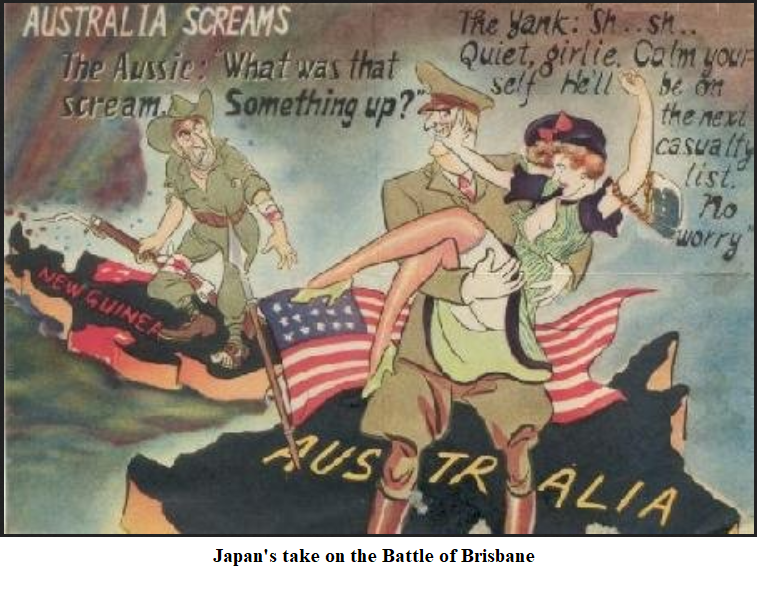
Film can be, and was then, a powerful medium especially for a child. Propaganda films succeeded in their purpose with me. I never doubted the courage and resolution, heedless of the recklessness of Noel Coward in In Which We Serve, playing a thinly disguised Louis Mountbatten as captain of the Kinross. I even swallowed whole the preposterous plot of We Dive at Dawn.
My brothers’ and my weekly treat was a session, late on Friday afternoon, first a newsreel, then a cartoon, a B grade and an A grade film, at a city picture theatre. Peter and I took it in turn to choose the films. Insensitive to the concerns of our mother, whose son and father were on active service, we always chose war films. Our favourites included This Above All and, of course, Casablanca. Stiff lips were the order of the day.
It was a time of excitement for a child. My mother kept open house for airmen and soldiers, friends of my father and Jimmy passing through Brisbane, as many of them did, some wounded and some lucky enough to have finished their deployment intact. We had much of the excitement, but none of the danger the children depicted in the 1986 film Hope and Glory faced during the London Blitz.
In Brisbane we collected old aluminium pots and pans, paper and used tyres for the war effort, and experienced mild rationing, but never went without a sufficient supply of anything we needed. Immediately after VP Day we lit a bonfire in a nearby park for which some of the boys had made cardboard effigies of Tojo to be consumed by the flames.
It was a film though, that defined the end of the war for me, a British film written by Anatole de Grunwald and Terence Rattigan after the latter was taken out of service as a rear gunner of a bomber and better employed in his metier as a playwright and screenwriter. The Way to the Stars is a beautiful, sentimental and uplifting film that begins on a now deserted English airfield, Halfpenny Field, on which a British and US bomber squadron had successively been based during the war. I well remember a seventeen-year-old Jean Simmons tripping on to the stage to sing at a concert in one of the climactic scenes:
Let him go, let him tarry, let him sink or let him swim
He doesn’t care for me and I don’t care for him
He can go and find another that I hope he will enjoy
For I’m going to marry a far nicer boy.
After the war, Oliver, unlike most of the US servicemen who married Australian women, chose to live in Australia. He and Rose had a long and happy marriage. A more distant cousin was less lucky. She married a Tennessee mountain boy, not quite Li’l Abner, but on his home ground a quite different man from the tidily uniformed young soldier who had courted her in Brisbane.
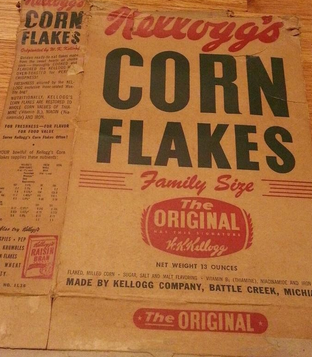
Jimmy, who once had a single stripe as an acting lance corporal for about a week, was proud of the distinction of leaving the Army after four and a half years of active service with the same rank as he had entered it: private.
Years afterwards, on a visit to Jimmy’s bedside as he was cheerfully fading—he was always cheerful—I asked him why he had been riding his motorbike on the beach at Lae.
“The Japs weren’t after me,” he said. “It was a grounded landing craft. They mustn’t have known it was disabled.”
I asked him what happened to the courageous Americans who dug him out under the bombing and the strafing that followed it. He looked thoughtful. “They had a good Jeep.” I waited. He added, “My mates and I took it.” It was not for nothing that the Ninth Division was called “General Morshead and his Twenty Thousand Thieves”.
Well, why were you near the landing craft? I persisted.
“I wanted the cornflakes. I’d seen a packet of them in the galley.”
Jimmy died about a week later.
The Hon. Ian Callinan is a novelist and a former judge of the High Court of Australia
Madam: Archbishop Fisher (July-August 2024) does not resist the attacks on his church by the political, social or scientific atheists and those who insist on not being told what to do.
Aug 29 2024
6 mins
To claim Aborigines have the world's oldest continuous culture is to misunderstand the meaning of culture, which continuously changes over time and location. For a culture not to change over time would be a reproach and certainly not a cause for celebration, for it would indicate that there had been no capacity to adapt. Clearly this has not been the case
Aug 20 2024
23 mins
A friend and longtime supporter of Quadrant, Clive James sent us a poem in 2010, which we published in our December issue. Like the Taronga Park Aquarium he recalls in its 'mocked-up sandstone cave' it's not to be forgotten
Aug 16 2024
2 mins







